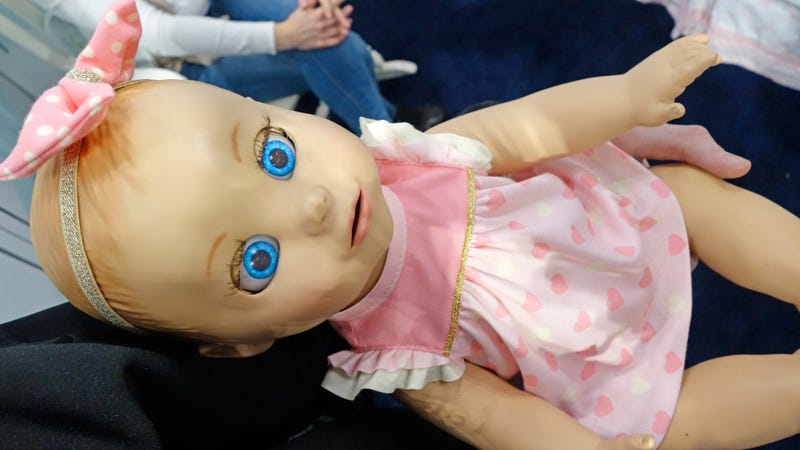
The aisles of Toy Fair are filled with dolls of all shapes and sizes that can eat, cry, talk, and even require a diaper change. But Spin Master’s Luvabella feels like a quantum leap when it comes to interactive toy babies. After playing with her for just a few minutes, I somehow walked away feeling like a neglectful dad for leaving her behind.
Why kids have a deep urge to take care of even smaller versions of themselves is a question best left to child psychologists, but Spin Master’s Luvabella is the first doll that genuinely makes it feel like you’re taking care of a needy infant, and that your actions and interactions have real-life consequences. It’s partly a result of advanced animated features like blinking eyes, a pursed mouth than can suck a pacifier, and flailing arms. But it’s also a result of hidden sensors that provide constant feedback to a robust artificial intelligence that brings all of those elements together.
Most dolls that boast interactive features tend to only focus on a single behaviour like realistic eating, or crying. But Luvabella replicates a bunch of lifelike infant behaviors, at the same time, that are constantly responding to how you’re holding or playing with her. Tickle her feet and she’ll laugh, and cover her eyes and she’ll play peek-a-boo or get upset if you leave them covered for too long. Watching people pass the doll around like it could get seriously hurt if dropped was kind of remarkable.
The doll will also slowly learn how a child plays with it, and react more positively to common interactions, assuming it’s their parent’s favorite. It can even learn to talk, progressing from simple baby grunts and murmurs, to actual recognizable words over time. But given concerns over privacy, Spin Master has kept Luvabella completely offline—there’s no wi-fi connections—and no app interactivity. The doll can’t ever be upgraded as a result, but it also means the company isn’t secretly picking through your kids’ conversations and interactions for marketing insights. We’re looking at you, Hello Barbie.
At times the Luvabella doll we played with at Toy Fair was undoubtedly creepy, with eyes that seemed to stare right through you. But it was also a semi-functional prototype given the final $ 100 toy isn’t set to hit shelves until the Fall. Its motions and facial features will hopefully be further refined by then, but that might not be a good thing. If and when your child eventually stops playing with it, parents who’ve already raised an infant will undoubtedly feel like they should continue taking care of it.

